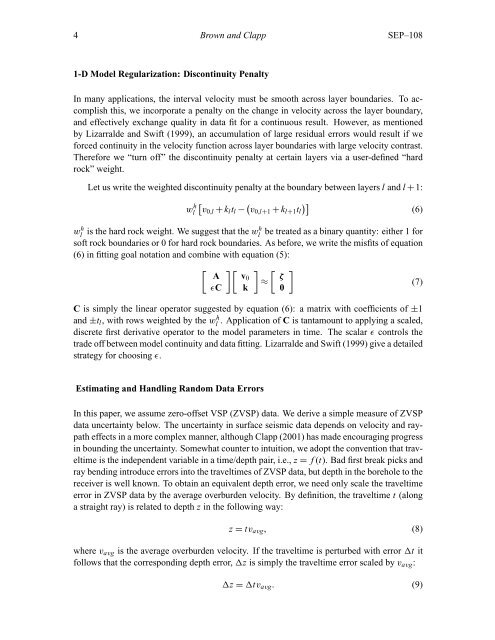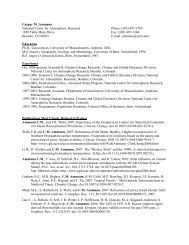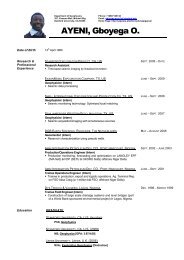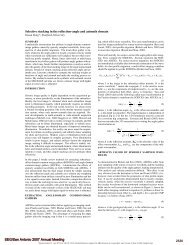pdf 349K - Stanford Exploration Project - Stanford University
pdf 349K - Stanford Exploration Project - Stanford University
pdf 349K - Stanford Exploration Project - Stanford University
You also want an ePaper? Increase the reach of your titles
YUMPU automatically turns print PDFs into web optimized ePapers that Google loves.
4 Brown and Clapp SEP–108<br />
1-D Model Regularization: Discontinuity Penalty<br />
In many applications, the interval velocity must be smooth across layer boundaries. To accomplish<br />
this, we incorporate a penalty on the change in velocity across the layer boundary,<br />
and effectively exchange quality in data fit for a continuous result. However, as mentioned<br />
by Lizarralde and Swift (1999), an accumulation of large residual errors would result if we<br />
forced continuity in the velocity function across layer boundaries with large velocity contrast.<br />
Therefore we “turn off” the discontinuity penalty at certain layers via a user-defined “hard<br />
rock” weight.<br />
Let us write the weighted discontinuity penalty at the boundary between layers l and l +1:<br />
w h l<br />
�<br />
v0,l + kltl − � ��<br />
v0,l+1 + kl+1tl<br />
wh l is the hard rock weight. We suggest that the wh l be treated as a binary quantity: either 1 for<br />
soft rock boundaries or 0 for hard rock boundaries. As before, we write the misfits of equation<br />
(6) in fitting goal notation and combine with equation (5):<br />
� A<br />
ɛC<br />
�� v0<br />
k<br />
C is simply the linear operator suggested by equation (6): a matrix with coefficients of ±1<br />
and ±tl, with rows weighted by the wh l . Application of C is tantamount to applying a scaled,<br />
discrete first derivative operator to the model parameters in time. The scalar ɛ controls the<br />
trade off between model continuity and data fitting. Lizarralde and Swift (1999) give a detailed<br />
strategy for choosing ɛ.<br />
�<br />
≈<br />
Estimating and Handling Random Data Errors<br />
In this paper, we assume zero-offset VSP (ZVSP) data. We derive a simple measure of ZVSP<br />
data uncertainty below. The uncertainty in surface seismic data depends on velocity and raypath<br />
effects in a more complex manner, although Clapp (2001) has made encouraging progress<br />
in bounding the uncertainty. Somewhat counter to intuition, we adopt the convention that traveltime<br />
is the independent variable in a time/depth pair, i.e., z = f (t). Bad first break picks and<br />
ray bending introduce errors into the traveltimes of ZVSP data, but depth in the borehole to the<br />
receiver is well known. To obtain an equivalent depth error, we need only scale the traveltime<br />
error in ZVSP data by the average overburden velocity. By definition, the traveltime t (along<br />
a straight ray) is related to depth z in the following way:<br />
� ζ<br />
0<br />
�<br />
(6)<br />
(7)<br />
z = tvavg, (8)<br />
where vavg is the average overburden velocity. If the traveltime is perturbed with error �t it<br />
follows that the corresponding depth error, �z is simply the traveltime error scaled by vavg:<br />
�z = �tvavg. (9)







